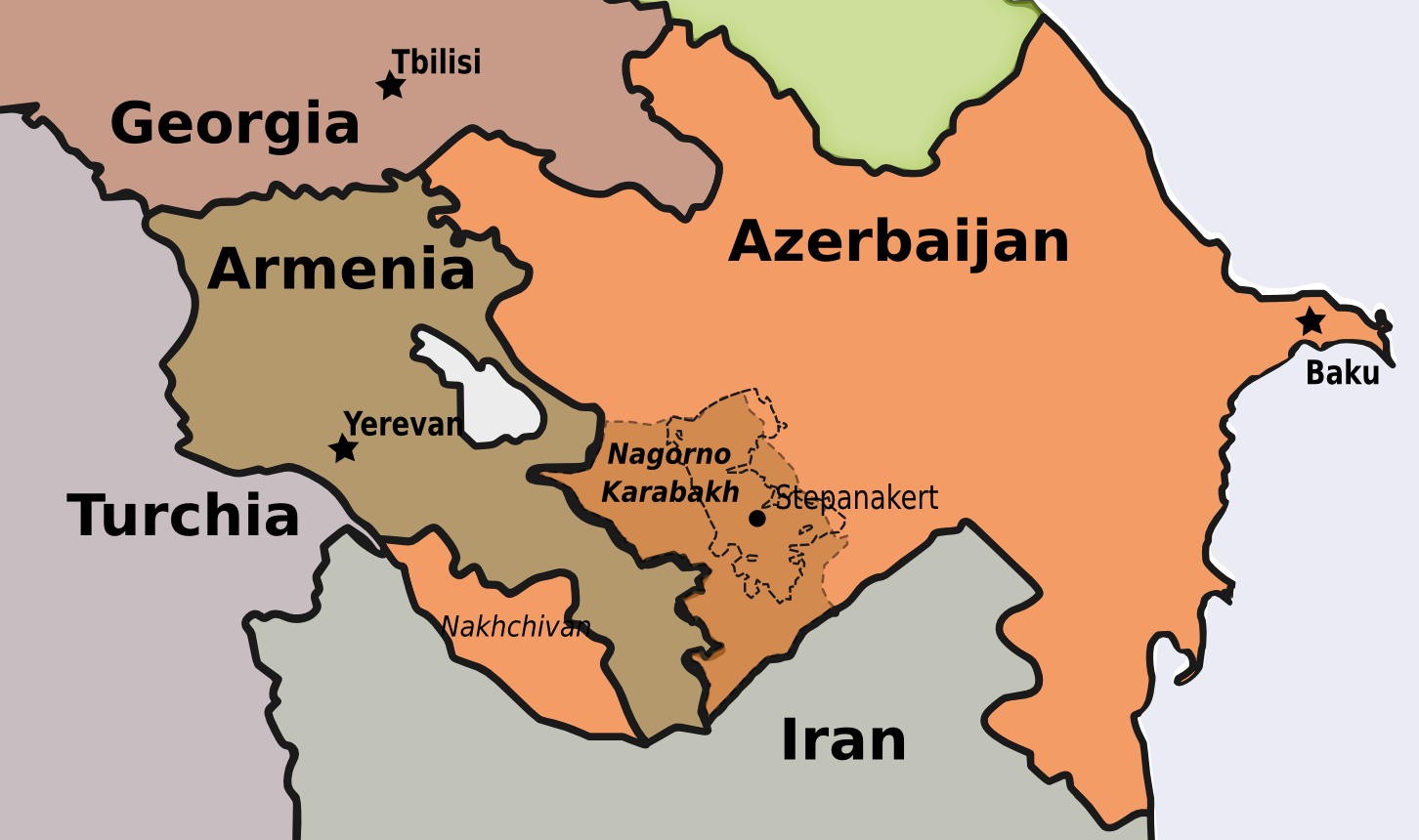
Conflict turned Negotiation: history being written in Armenia and Azerbaijan
With the onset of the year 2024, the world saw a transformation in the political affairs and international relations of the Caucasus region. One such alteration is seen in the South Caucasus region between Armenia and Azerbaijan. The decades-long hostility between the two over the territory of Nagorno-Karabakh has slackened down.
On 21st September 2023, after a one-day military operation of Azerbaijan in Nagorno-Karabakh, the ethnic Armenians of Nagorno-Karabakh and Azerbaijan decided to negotiate. Following these events, the peace talks started between Azerbaijan and Armenia as well. However, the question arises: how did these two states agree to negotiate after three decades of hostility and conflict?
To trace the developments of the contemporary events, we need to dig into the historical events.
History of the Nogorno-Karabakh Region:
The Nagorno-Karabakh, which comprised 95% of ethnic Armenians, was amalgamated into the Soviet Azerbaijan in 1923. However, in 1987 the ethnic Armenians of Nagorno-Karabakh demanded unification to Armenia from Moscow. Yet, this petition was not accepted. In 1991, with the disintegration of the USSR, the first full-scale war escalated between Armenia and Azerbaijan, which resulted in 25,000 deaths and a million refugees on both sides. The war ended through negotiations due to the Russian involvement in 1994.

In 1997, a committee named the OSCE (the Organization on Security and Cooperation in Europe) Minsk group was formed by the CSCE (council on Security and Cooperation in Europe) to promote peace and increase cooperation between Armenia and Azerbaijan. The committee is led by Russia, France, and the US. The Minsk group gave several proposals for peace but they could not reach the final destination due to the mutual distrust and the clash of interests between Armenia and Azerbaijan. Consequently, the conflicts over the borders, high investments in the military, the use of attack drones, and military operations escalated the tensions between Armenia and Azerbaijan.
Recent Clashes in the Region:
Further, the second war between them occurred in September 2020 when Azerbaijan conducted an offensive along the line of control that was controlled by Armenians and the local fighters. After 6 days of armed conflict and the deaths of more than thousands of soldiers and civilians, the war came to an end through a ceasefire with Russian involvement.
As a consequence of the war, Azerbaijan gained control over the significant territories of Nagorno-Karabakh while Armenia was left with only 14% of Nagorno-Karabakh. However, the capital of Nagorno-Karabakh, known as Stepanakart, was left under the control of the local ethnic Armenians.
Throughout 2021, Armenia and Azerbaijan were involved in sporadic tensions and border clashes. For instance, Armenia accused Azerbaijan of conflicts in several areas of Nagorno-Karabakh mainly Goris, Sotk, and Jermuk. Azerbaijan’s military accepted this allegation but it accused Armenia of building mines and plants along the borders that as a result caused issues in the supply routes.
Further, in December 2022, Azerbaijan blocked the Lachin corridor which was vital for trade for Armenia. This brought several disastrous consequences for 120,000 ethnic Armenians in the form of human death, food shortage, and health issues. In August 2023, the UN asked Azerbaijan to uplift the blockade and end the humanitarian crisis. Likewise, in October 2023 UN sent a committee of the International Committee of the Red Cross (ICRC) to look at the humanitarian conditions in Nagorno-Karabakh and to work for its betterment.
September 2023 – the triggering point
A triggering event occurred on 19th September 2023, when the Azerbaijan military conducted a-day military offensive in Nagorno-Karabakh. They called this offensive “anti-terrorist activities”. Further, it caused a huge proportion of ethnic cleansing in Nagorno-Karabakh and led 120,000 ethnic Armenians to flee the land. This offensive aimed at the dissolution of the ethnic Armenian self-government in Nagorno-Karabakh.
Owing to the ceasefire on the 20th of September 2023, Azerbaijan gained control over Nagorno-Karabakh as a whole. Nagorno-Karabakh’s separatist leader, Samvel Shahramanyan, declared the dissolution of all the institutions of Nagorno-Karabakh on 1st January 2024. Moreover, the president of Azerbaijan, Ilham Aliyev, assured that equal rights will be given to the ethnic Armenians in Nagorno-Karabakh.
Geopolitics of the Reconciliation
In the light of these events, Armenia and Azerbaijan came forward for reconciliation. Armenia had been a longtime ally of Russia but Russia’s silence over Azerbaijan’s offensive in the Nagorno-Karabakh and the blockade of the Lachin corridor has reduced Armenia’s reliance on Russia. Simultaneoulsy, it has increased its tilt towards the West. As a result, the Armenian president, Nikol Pashinyan, met with the administrator of the US Agency for International Development, Samantha Power, on 5th April 2024 in Brussels. This meeting aimed to assist USAID in Armenia so that it can progress economically and strengthen democracy.
This meeting was also joined by the EU which declared to support Armenia for its infrastructural projects through the implementation of the comprehensive and enhanced partnership agreement (CEPA). By this project, the EU will provide EUR 270 million for the growth of Armenia. Thus, this aid aims to take Armenia to the road of development and help it to proceed with negotiations with Azerbaijan so that a durable peace can be witnessed in the region.
What the Future Potentially Looks Like for Armenia and Azerbaijan:
The good relations between Azerbaijan and Armenia will bring several positive outcomes. It will provide a better trade route by the International North-South Transport Corridor (INSTC) via Iran and Central Asia to Russia. This trade route will be vital for economic progress and connectivity of the states of the region. Further, both states can work on the Zangezur corridor, which will provide a trade route through Baku, Kars, Turkey, Armenia, and Iran.
This better and more reliable trade route will help the two states to cooperate for joint projects, resulting in the economic development of Azerbaijan and Armenia particularly, and the whole region generally. Consequently, such mutual projects will increase the dependency of the two states on each other, which will allow them to work for mutual harmony and peace by avoiding conflicts.
This increased cooperation can bring further developments in the social sector such as exchange programs, cultural interfaith, and educational investments. Moreover, the decreased investment in the military, due to the absence of conflict, will help them to invest in the social welfare of their public. As a result, the public will not have grievances from the government and they will be able to take part in the development of the state. Likewise, this situation will strengthen democracy in both states and so does stability.
Read More: It’s Black and White: Not Every Story Has “Two Sides”
Conclusion
Thus, the reconciliation between Armenia and Azerbaijan is an essential step towards the progress of the social, political, and economic sectors of both of the states. In a nutshell, Armenia and Azerbaijan have been rivals for three decades, which caused instability in the South Caucasus region. In the contemporary days, both states have realized the significance of negotiations. Therefore, they have come forward for dialogue to put their differences aside and work for mutual gains. Hence, this reconciliation between them will prove to be a path to the development of the whole region.
The author is a BS International Relations student at BUITEMS. She possesses a keen interest in geopolitics and peace studies.


